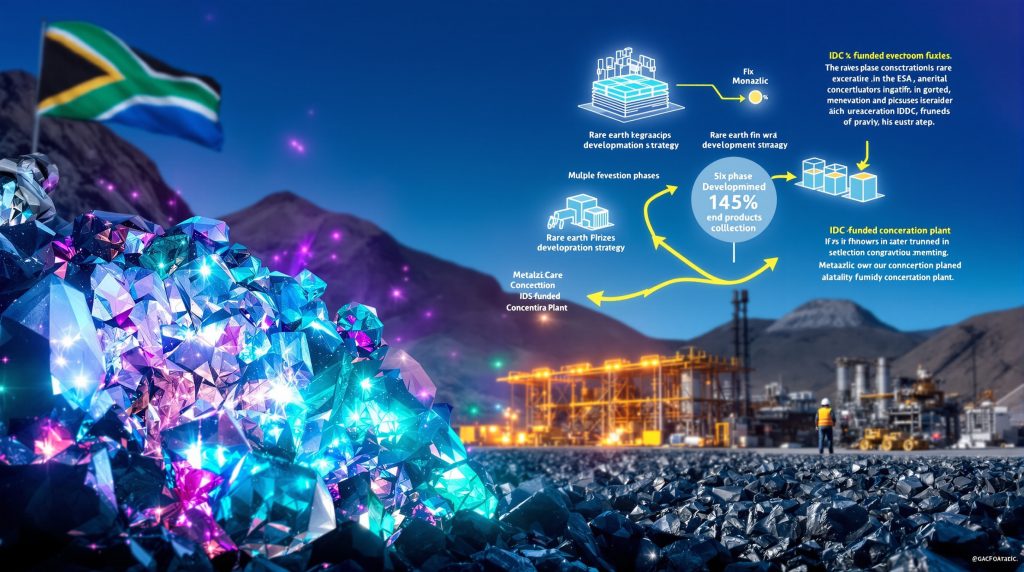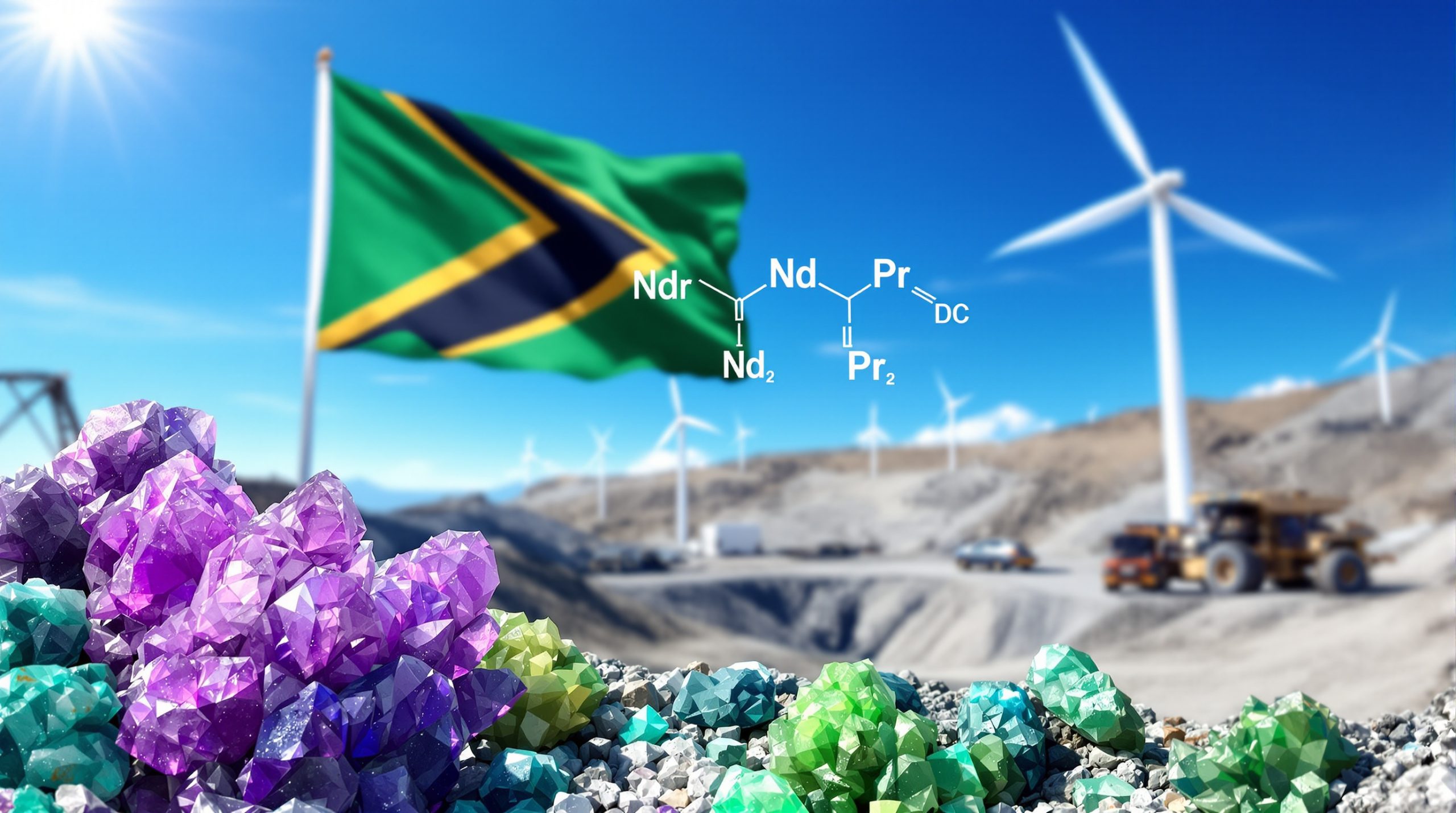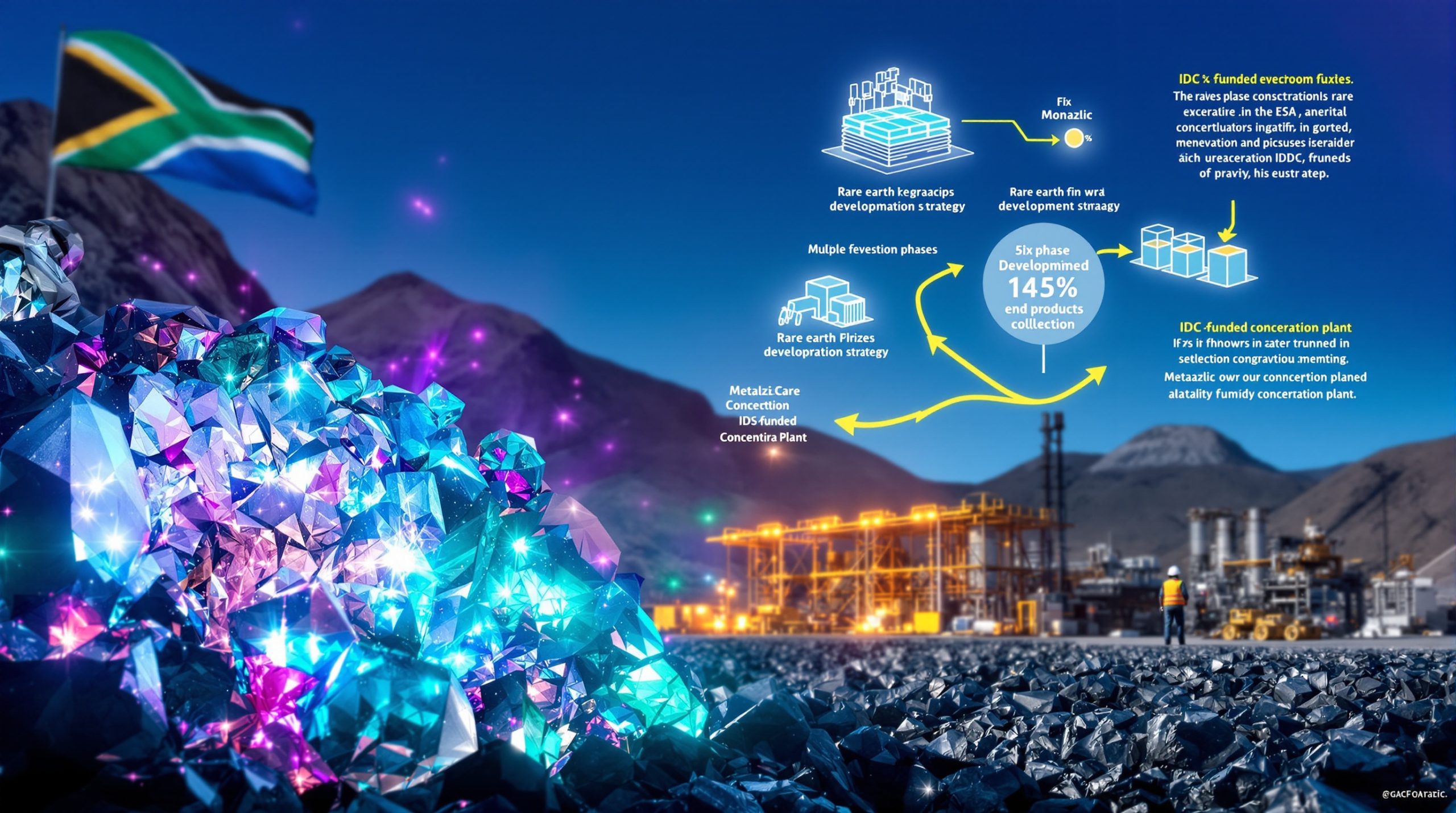Understanding the Steenkampskraal Rare Earths Project: A Mining Revolution
The rare earth elements sector is witnessing a significant development with the Steenkampskraal Monazite Mine (SMM) project advancing through strategic funding from the Industrial Development Corporation (IDC). This South African project stands poised to transform the global rare earth supply chain through an innovative six-phase implementation strategy focused on complete value chain development.
High-Grade Deposit with Exceptional Potential
Steenkampskraal represents one of the world's highest-grade rare earth and thorium deposits, featuring remarkable mineral concentrations that set it apart from typical global reserves. With an average run-of-mine grade of 14.4% and concentrated Total Rare Earth Oxides (TREO) percentages reaching 40-50%, the mine offers exceptional economic potential.
Most global rare earth deposits contain significantly lower concentrations, typically below 5%, making Steenkampskraal's grade profile truly exceptional. This natural advantage positions the project to potentially become one of the most cost-effective rare earth operations worldwide, with production expenses substantially below industry averages.
The deposit's monazite ore contains a diverse range of rare earth elements critical to modern technologies, from neodymium and praseodymium used in permanent magnets to dysprosium and terbium essential for high-temperature applications. This diversity provides flexibility in addressing various market demands across technology sectors.
Geographic and Strategic Significance
Located in South Africa's Western Cape province, the Steenkampskraal project represents a strategic asset within the global critical minerals energy transition. South Africa has historically been underrepresented in the rare earth value chain despite its rich mineral endowment, with most production concentrated in China and limited processing capability outside Asian markets.
The project offers South Africa an opportunity to reduce dependency on international suppliers while establishing itself as a significant player in the critical minerals sector. This aligns with broader continental efforts to capture more value from Africa's natural resources through local processing and manufacturing.
For global supply chains, particularly those supporting green technologies and defense applications, Steenkampskraal provides much-needed geographical diversification. This reduces concentration risk that has challenged industries reliant on rare earth elements for years.
How IDC Funding is Transforming the Project
First Tranche Milestone Achievement
The Industrial Development Corporation has delivered its first funding tranche to Steenkampskraal Monazite Mine, marking a critical advancement in the project's development trajectory. This initial capital injection represents the first of four planned funding installments specifically allocated for constructing the Phase 1 concentration plant.
Dr. Enock Mathebula, Steenkampskraal Chairperson, highlighted the significance of this development: "This first tranche marks a major milestone in progressing SMM toward steady-state production of Monazite Concentrate as Phase 1 of the company's broader production strategy."
The funding milestone transitions the project from planning and design phases into active construction and implementation, accelerating the timeline toward initial production of high-grade rare earth concentrates.
Financial Structure and Development Timeline
The IDC's approach to Steenkampskraal funding follows a structured, milestone-based model designed to align capital deployment with project achievement. Rather than providing all capital upfront, the four-tranche structure creates accountability checkpoints while reducing investor risk through staged validation.
This phased funding specifically targets the mine's immediate priorities, with emphasis on constructing metallurgical processing facilities critical to producing marketable rare earth concentrates. The strategic sequencing of capital deployment matches the project's methodical implementation roadmap.
While specific monetary amounts have not been publicly disclosed, mining industry analysts estimate total Phase 1 implementation costs could range from $20-30 million based on comparable processing facility developments. The sequential tranche structure typically allows for operational adjustments based on initial construction learnings.
Economic Impact Beyond Capital
IDC's investment serves multiple strategic purposes beyond providing essential financial resources. As Graham Soden, CEO of SMM, explains: "The IDC's investment is not only a financial boost but also a catalyst for broader economic benefits. Through this support, Steenkampskraal is strengthening South Africa's industrial base, creating employment opportunities in both direct mining operations and downstream mineral beneficiation opportunities."
The project is expected to create approximately 100-150 direct jobs during initial phases, with employment multiplying through subsequent value-chain expansions. Additionally, the technical nature of rare earth processing will develop specialized skills within South Africa's mining workforce, creating knowledge transfer benefits beyond immediate employment figures.
The IDC's involvement also provides market validation that can attract additional investors and technical partners necessary for implementing later development phases. This catalytic effect amplifies the initial capital impact through partnership facilitation and risk reduction.
What Makes the Six-Phase Development Strategy Innovative
Phase 1: Monazite Concentrate Production
The initial phase focuses on establishing steady-state production of high-grade monazite concentrate containing over 50% Total Rare Earth Oxides (TREO). This concentrate will be produced at remarkably competitive costs due to the exceptional grade of the deposit.
The concentration process employs physical separation techniques including crushing, grinding, flotation, and gravity separation. These well-established mineral processing methods minimize technical risk while maximizing recovery rates from the high-grade ore.
The Phase 1 plant design incorporates flexibility to accommodate variations in ore characteristics while maintaining product quality specifications. This adaptability ensures consistent concentrate quality regardless of mining zone variations within the deposit.
Phase 2: Advanced Processing Implementation
The second development stage will introduce production of cerium- and lanthanum-depleted Mixed Rare Earth Carbonate (CLDMREC) using proven technology provided and operated by Chimerical Technology (Pty) Limited, adding significant value to the initial concentrate.
This strategic processing step addresses a key market reality: cerium and lanthanum typically constitute 80-85% of rare earth deposits by volume but represent lower economic value than other elements in the mix. By selectively removing these abundant elements, the remaining concentrate contains higher percentages of more valuable heavy and medium rare earths.
The chemical processing techniques employed in this phase represent intermediate technology complexity—more advanced than physical separation but less complex than full elemental separation. This balanced approach maximizes value addition while managing implementation risk.
Phase 3: Revolutionary Separation Technology
In partnership with the Remedy Group, the third phase will implement breakthrough magneto-electrochemical separation processes at or near the mine site, enabling on-site rare earth element separation that significantly reduces dependency on offshore processing.
This innovative technology represents a potential paradigm shift in rare earth processing. Traditional separation methods rely on hundreds of solvent extraction stages requiring substantial chemical inputs and generating significant waste streams. The magneto-electrochemical approach offers potentially lower environmental impact with reduced chemical consumption.
On-site separation capability addresses one of the most persistent bottlenecks in global rare earth supply chains—limited separation capacity outside China. By localizing this critical capability, Steenkampskraal reduces geopolitical supply risk while capturing additional value within South Africa.
Phase 4: Fluorination Innovation
The fourth phase will implement a patented fluorination process through collaboration with Rare Earth Refiners to produce rare earth fluorides, further advancing the value chain within South Africa's borders.
Rare earth fluorides represent intermediate compounds with applications in various high-technology manufacturing processes. The fluorination technology delivers products with specific physical and chemical properties required for specialized applications in metallurgy, electronics, and glass manufacturing.
This phase represents progression into higher-value specialty chemical production beyond basic mineral processing or preliminary chemical treatment. The intellectual property embedded in the patented process provides competitive advantage while creating barriers to competitive entry.
Phase 5: Metallization Partnerships
The fifth development phase will focus on metallization operations at or near the mine site, currently under discussion with selected global reduction companies, further extending the value chain.
Metallization represents the critical transition from chemical compounds to usable metals—a step that significantly increases product value while enabling direct application in manufacturing processes. This capability addresses another traditional gap in non-Chinese rare earth supply chains.
The reduction processes convert rare earth compounds into pure metals or alloys through specialized high-temperature metallurgical techniques. These processes require precise control and specialized equipment, representing significant technological complexity and capital investment.
Phase 6: End-Product Manufacturing
The final phase aims to establish production facilities for various separated end-products at or near the mine site, with discussions underway with global rare earth product manufacturers to complete the value chain.
This ambitious stage would transform Steenkampskraal from a mining and processing operation into an integrated manufacturing center producing components for high-technology applications. Potential products could include permanent magnets for electric vehicles and wind turbines, specialized catalysts, precision optics, and other high-value applications.
Full vertical integration would position South Africa as one of few countries globally with capability across the entire rare earth value chain. This comprehensive approach contrasts sharply with typical mining industry evolution projects that extract and export raw materials with minimal processing.
Why This Project Matters for South Africa's Industrial Strategy
Alignment with National Beneficiation Strategy
The Steenkampskraal project directly supports South Africa's official Minerals Beneficiation Strategy, adopted in June 2011. As Dr. Mathebula explained during the project's presentation at the 9th Tokyo International Conference on African Development (TICAD-9) in Yokohama, Japan, this strategy aims to transform the country's mineral wealth into competitive economic advantage through downstream value addition.
The beneficiation strategy specifically targets minerals where South Africa has significant reserves but limited processing capability. Rare earths represent a perfect case study—high-value minerals currently exported with minimal processing that could generate substantially greater economic returns through local value addition.
Each phase of Steenkampskraal's development aligns with specific beneficiation objectives, progressively moving up the value chain from basic concentration to sophisticated manufacturing. This systematic approach demonstrates practical implementation of policy goals often challenging to realize in mining contexts.
Industrial Development Catalyst
By progressively moving up the rare earth value chain, Steenkampskraal contributes to broader industrialization initiatives focused on improving export quality, creating sustainable employment, diversifying the economy, and building knowledge-driven industrial capabilities.
The technological complexity of rare earth processing creates opportunities for industrial cluster development, with potential suppliers, research institutions, and related businesses establishing operations to support the growing value chain. These industrial ecosystems frequently generate innovation spillovers that benefit adjacent sectors.
South Africa's existing mining infrastructure and expertise provide advantages for rapid capability development. The project leverages established mining competencies while expanding into new technological domains that complement existing industrial strengths.
Strategic Positioning in Global Supply Chains
The phased development approach positions South Africa to become a significant participant in the global rare earths industry, particularly important as these elements are essential for technologies driving the green transition and advanced manufacturing.
Global demand for rare earth elements continues growing at 8-12% annually, driven by renewable energy, electric vehicles, electronics, and defense applications. However, supply chains remain concentrated, with China controlling approximately 85% of processing capacity despite holding only about 35% of reserves.
By establishing independent processing capability across multiple stages, Steenkampskraal helps address persistent global supply vulnerabilities while positioning South Africa advantageously in high-growth markets driven by sustainability initiatives and technological development.
What Additional Opportunities Does the Project Present
Medical Applications Through Thor Medical
Beyond industrial applications, Thor Medical is working with Steenkampskraal and select local funders to advance agreements for harvesting Radium-228, which has applications in targeted Alpha therapy for cancer treatment, adding a healthcare dimension to the project's benefits.
Radium-228 serves as a precursor for Actinium-225, one of the most promising radioisotopes for cancer treatment. These radiopharmaceuticals allow precise targeting of cancer cells while minimizing damage to surrounding healthy tissue, representing a frontier in oncology treatment.
The thorium content in Steenkampskraal's deposit, often considered a complication in rare earth mining, becomes an advantage in this application. By extracting value from multiple elements within the deposit, the project improves overall resource utilization and economic returns.
Technology Transfer and Innovation Hub
The progressive implementation of advanced processing technologies creates opportunities for South Africa to develop expertise in rare earth processing, potentially establishing the region as an innovation hub for critical mineral technologies.
Each processing phase involves technology transfer agreements that build local technical capabilities. These partnerships accelerate South Africa's technological learning curve while establishing indigenous expertise that can be applied to other mineral resources.
Research partnerships with South African universities and technical institutions can further accelerate innovation, creating opportunities for developing next-generation processing technologies. This knowledge ecosystem enhances national technological sovereignty in critical minerals reserve.
Supply Chain Security for Green Technologies
As a reliable supplier of rare earth elements essential for renewable energy technologies, electric vehicles, and electronics, Steenkampskraal contributes to global supply chain security for critical components of the green transition.
Wind turbines, electric vehicle motors, and energy-efficient lighting all depend on specific rare earth elements. As climate initiatives accelerate worldwide, secure access to these materials becomes increasingly strategic for industries and governments alike.
Steenkampskraal's development timeline aligns with projected supply gaps for specific rare earth elements expected to emerge between 2025-2030. By entering production during this critical window, the project addresses market needs while potentially benefiting from favorable pricing conditions.
How This Project Compares to Other Global Rare Earth Developments
Competitive Advantages in Global Context
With its exceptionally high grade (14.4% average run-of-mine), Steenkampskraal possesses natural advantages over many global competitors whose deposits typically contain significantly lower concentrations of rare earth elements, often below 5%.
This grade advantage translates directly to economic performance. Mining operations typically find extraction costs inversely proportional to ore grade—higher concentrations mean less material must be mined, moved and processed for equivalent output, reducing energy consumption, equipment wear, and operational expenses.
The project's monazite mineralogy also offers processing advantages compared to deposits containing complex mineralizations requiring more intensive separation techniques. This mineralogical simplicity reduces technical risk while improving recovery rates.
Integrated Value Chain Approach
Unlike many rare earth projects that focus solely on mining or preliminary processing, Steenkampskraal's six-phase strategy encompasses the entire value chain from mining through to end-product manufacturing, representing a more comprehensive approach than most competitors.
Most new rare earth projects globally limit their scope to mining and basic concentration or initial chemical processing. This limited approach leaves substantial value capture to downstream participants, typically in China or other manufacturing centers.
Steenkampskraal's vertical integration strategy, while more complex to implement, offers greater economic returns and strategic value. The approach more closely resembles Japanese and European models focused on securing entire supply chains rather than North American approaches that typically emphasize mining without equivalent attention to processing.
Sustainable Development Framework
The project's emphasis on local beneficiation and value addition aligns with sustainable development principles, potentially offering environmental and social advantages compared to operations that separate mining from processing across multiple countries.
Localizing multiple processing stages reduces transportation requirements, lowering both costs and carbon emissions associated with moving materials between distant facilities. This geographically concentrated approach improves overall sustainability performance while enhancing economic returns.
The comprehensive development strategy also creates more diverse employment opportunities spanning multiple skill levels, from mining operations to advanced manufacturing. This diversified employment base builds community resilience while creating career advancement pathways.
What Challenges Must Be Navigated for Success
Technical Implementation Complexities
Each phase of the development strategy involves complex technical processes that must be successfully implemented, requiring careful management of technological risks and operational integration.
The progressive complexity increase across phases demands systematic capability building, with each stage establishing operational foundations for subsequent developments. This sequential approach requires disciplined project management and technology validation between stages.
Particular attention must focus on scaling technologies from demonstration to commercial implementation. Processes proven at laboratory or pilot scale often encounter unexpected challenges during full-scale implementation that require additional engineering solutions.
Market Dynamics and Price Volatility
The rare earth market has historically experienced significant price volatility, requiring strategic planning to ensure the project remains economically viable through potential market fluctuations.
Price spikes in 2010-2012 saw some rare earth prices increase 3,000% before subsequently collapsing, demonstrating the market's potential instability. While Steenkampskraal's high grades provide cost advantages that offer protection during low-price periods, prudent financial planning must account for potential volatility.
The market also exhibits significant element-specific variations, with certain rare earths experiencing supply shortages while others remain abundant. Strategic flexibility in production mix and processing capabilities helps manage these differential market conditions.
Regulatory and Environmental Considerations
As with any mining and processing operation, navigating regulatory requirements and ensuring environmental compliance presents ongoing challenges that must be effectively managed.
Rare earth processing involves complex chemical operations that require stringent environmental controls and waste management protocols. Meeting these requirements while maintaining economic competitiveness demands sophisticated engineering solutions and operational discipline.
South Africa's mining regulations have evolved substantially in recent years, with increasing emphasis on environmental protection, community benefits, and sustainable development. Proactive engagement with regulatory frameworks and community stakeholders remains essential for project success.
Further Development and Market Outlook
Steenkampskraal's phased development approach creates flexibility to adapt to evolving market conditions while systematically building capabilities. This methodical strategy balances ambition with pragmatic implementation, addressing both immediate production opportunities and longer-term strategic positioning.
The project's participation in international forums such as TICAD-9 demonstrates its global relevance and potential for cross-border partnerships. These international connections provide both market access and technical collaboration opportunities essential for navigating the complex rare earth value chain.
As global demand for critical minerals strategy continues expanding through energy transition and technological advancement, Steenkampskraal's strategic development positions South Africa to capture increasing value from its mineral endowment while contributing to global supply chain security for essential materials.
Disclaimer: This article contains forward-looking statements regarding mining development, market conditions, and technical implementation. Actual results may vary based on geological conditions, technical challenges, market dynamics, and regulatory developments. Readers should consider these factors when evaluating investment or strategic decisions related to rare earth elements and mining projects.
Ready to Identify Mineral Discoveries Before the Market?
Discover how top investors consistently capitalise on ASX mineral discoveries using Discovery Alert's proprietary Discovery IQ model, delivering real-time, actionable insights straight to your inbox. Explore historic returns of major discoveries on the dedicated discoveries page and position yourself ahead of the market.




